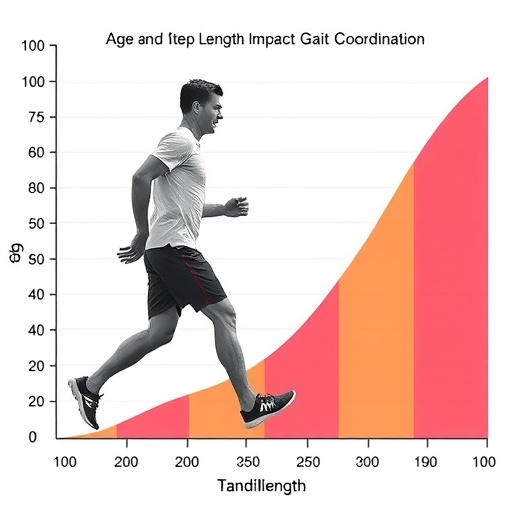In the realm of biomechanics and geriatric studies, recent research led by W. Jeon and colleagues presents a significant advancement in our understanding of how age and varying step lengths can alter muscle synergies and joint coordination, especially during unexpected gait termination events. The findings of this study have implications for clinical practices aimed at improving mobility and preventing falls among older adults. The implications of this research are vast and can influence how physical therapy and rehabilitation strategies are designed in the future.
Unexpected gait termination refers to the body’s response to sudden disruptions during walking, an event that can occur due to various environmental or situational factors. Given the aging population, understanding how these disruptions affect older adults is crucial. Older individuals often have altered motor patterns and reduced ability to stabilize their bodies when faced with abrupt stops. This study meticulously analyzes the changes in muscle recruitment and coordination patterns that arise in response to such events, highlighting the need for tailored interventions.
Initial results demonstrate a marked difference in muscle synergy and joint coordination as individuals navigate through unexpected gait termination based on their age and step length. Older adults showed distinct variations in how muscles were activated, which directly affects their stability and balance during such instances. These variations were further accentuated in tasks requiring longer steps, where the complexity of coordination increased drastically, thereby risking further instability and potential falls.
What makes this research particularly compelling is its methodological rigor. The team employed advanced biomechanical analysis techniques, including motion capture systems and electromyography, to capture the subtleties in muscle activation sequences and joint angles during sudden gait disruptions. This level of detail is unprecedented in previous studies involving older populations, thereby setting a new standard for future research in this area.
As the aging demographic continues to rise globally, the relevance of such studies cannot be overstated. With fall-related injuries being a leading cause of morbidity among the elderly, understanding the interplay between muscle control and external stimuli can guide the development of effective training programs. These programs can be designed to enhance resilience to sudden changes in walking patterns, thereby safeguarding against the risks associated with unexpected falls.
Moreover, the findings of this investigation hint at the necessity for personalized therapeutic strategies. By identifying how different individuals respond uniquely to unexpected circumstances based on their age and habitual step lengths, clinicians can curate rehabilitation regimens that specifically target their patients’ needs. This approach not only enhances the effectiveness of treatments but also equips individuals with essential skills to better manage their movements in everyday life.
Preventive measures could also be derived from this research, with potential applications in community settings. For instance, creating awareness and programs that simulate unexpected gait challenges could help individuals practice and enhance their readiness to deal with such events. Engaging older adults in directed physical activities that strengthen their response mechanisms during lapses in balance may ultimately contribute to reducing the incidence of falls.
As we delve deeper into the statistical analyses presented in the study, it’s evident that the researchers utilized a robust sample size to ensure the reliability of their findings. By accounting for a wide variety of factors, including health conditions and pre-existing joint issues, the authors strengthened the credibility of their conclusions. This meticulous attention to detail serves as a guiding principle for future investigations into age-related biomechanics.
Furthermore, the interplay between muscle synergies and joint coordination sheds light on fundamental neuromuscular dynamics that have broader implications beyond fall prevention. Enhancing our understanding of these relationships may lead to insights that could benefit not only aging adults but also individuals recovering from musculoskeletal injuries and neurological conditions. The adaptability of muscle systems and their coordination abilities is a critical factor that can be harnessed for clinical advancement.
Additionally, the comprehensive nature of the research offers potential pathways for future inquiry. The intersection of gait dynamics, muscle synergies, and cognitive load during walking are areas ripe for exploration. Future studies could expand on this foundation, incorporating variables such as dual-task scenarios or environmental obstacles, to further illuminate how these factors impact mobility in older adults.
In summary, Jeon and colleagues have made a significant contribution to the field of geriatrics and biomechanics with their comprehensive analysis of age- and step-length-dependent alterations in muscle synergies and joint coordination during unexpected gait termination. Their work is a testament to the importance of nuanced research designs in complex fields and serves as an essential stepping stone for subsequent studies that aim to improve outcomes for the aging population. By enhancing our understanding of these dynamics, the hope is to influence clinical practices fundamentally, ensuring that older adults can maintain their independence and quality of life for as long as possible.
This research not only bridges theoretical knowledge with practical applications but also emphasizes the urgent need for continuous exploration in this vital area of health science. As we anticipate future advancements, the foundation laid by such studies will illuminate paths toward innovation in therapeutic strategies and community health initiatives, ultimately fostering a healthier, more resilient aging population.
Subject of Research: Impact of age and step length on muscle synergies and joint coordination during unexpected gait termination
Article Title: Age- and step-length-dependent alterations in muscle synergies and joint coordination during unexpected gait termination
Article References:
Jeon, W., Dalby, A., Dong, X.N. et al. Age- and step-length-dependent alterations in muscle synergies and joint coordination during unexpected gait termination.
BMC Geriatr 25, 947 (2025). https://doi.org/10.1186/s12877-025-06562-9
Image Credits: AI Generated
DOI: https://doi.org/10.1186/s12877-025-06562-9
Keywords: Aging, Muscle Synergies, Joint Coordination, Gait Termination, Biomechanics
Tags: age-related gait changesbiomechanics of gait coordinationeffects of environmental factors on walking stabilityfall prevention strategies for seniorsgeriatric biomechanics researchimpact of step length on mobilitymuscle activation patterns in agingmuscle synergies and joint coordinationphysical therapy for gait improvementrehabilitation techniques for elderlytailored interventions for mobilityunexpected gait termination in older adults





